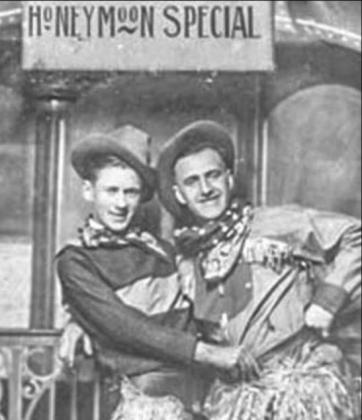Pride Month: The Gay Old West
Editor’s Note: Rebecca Huffstutler Norton is the Executive Director of the Frontier Times Museum.
As the LGBTQ community actively works for their rights and acceptance in today’s society, it’s easy to forget that homosexuality is not a contemporary development but rather has been present among humans since the dawn of time. An examination of frontier life indeed shows that love between same sex partners not only existed but was acceptable just as today.
An examination of historic photographs, memoirs and diaries of the era has preserved this often-overlooked part of western history. Through numerous diaries and letters, it is easy to see how nineteenth-century men and women were known for developing emotionally deep friendships with one another that often led to more intimate relationships that were not discouraged or frown upon.
The wild west was certainly untamed and uncultivated. Frontier life was one of isolation in wide open spaces where the constraints of civilization were not felt on one’s day to day life. In this environment, unconventional characters, lifestyles and differing types of behavior became more common and acceptable. The strong belief to live independently and unencumbered by societal norms could be applied as much to sexual freedom as anything else.
While little was written about it in the late 19th century and with Hollywood movies only presenting a more sanitized version of the Old West, it’s not surprising that this aspect of frontier life is not commonly known.
Yet, it is important to note the labels we employ today were not used in an earlier context.
Historian Peter Boag from the University of Colorado points out, “Society didn’t really designate people as homosexual or heterosexual through most of the 19th century; it was not really until the 20th century that those identities crystallized.”
Speaking from his 2003 book Same Sex Affairs, he explained to True West magazine, “In all-men societies, it was not unusual for same sex relationships, and it was just an acceptable thing to do. People engaged in same sex activities weren’t seen as homosexuals.”
In an environment where women were often not present, men sometimes displayed more erotic connections between themselves. A well-known example of this comes from a mining camp in Southern California that regularly held dances in which men danced with each other, with some of the men wearing patches over their pants crotch to indicate their role as the female partner. As human sexuality was studied scientifically for the first time in the mid-twentieth century, it was revealed by Alfred Kinsey in his 1948 study, “Sexual Behavior in the Human Male,” that homosexual behavior was more common in rural, more remote communities most likely because the isolation of such places “foster a ‘make do’ attitude’ … among pioneers and outdoor men.”
Homosexuality was not only common, but it appears it wasn’t considered a big deal among men who made do while living without female companions with some cowboys even creating same sex partnerships known as “bachelor marriages.”
Homosexuality within indigenous people appeared to have not only been acceptable but also revered. Many Native Americans viewed homosexuality in a positive light and embraced alternative gender roles. Tribal men who were more comfortable in the female realm and women who were more skilled in a man’s traditional role were valued and accepted as those who were of “Two Spirits.” Two Spirits have been documented in over 130 Native American tribes who thought of them as especially blessed with extra powers.
The 1970 Dustin Hoffman film, “Little Big Man”, includes a young Two-Spirit Trans character in a Cheyenne tribe. The Cheyenne called Two Spirit members, Hemaneh. Hemaneh were looked upon as important members within the tribe as they helped facilitate courtships and were looked upon as emphatic counselors and healers.
Frontier life provided easy cover for cross dressing as well. There are several known instances of both men and women dressing and living lives of the other gender as evidenced by numerous historical photographs and journal entries. Some lived their whole lives without detection only to be discovered upon death when their body was being prepared for the grave. One of the most famous cases was from George Armstrong Custer’s 7th Cavalry at Fort Lincoln in North Dakota. A corporal, John Noonan, married one of Custer’s longtime laundresses. She was very popular at the fort and served as a mid-wife for the other wives. Known for her comforting ways, she would be known for asking her expectant mothers, “Are you comf?"
The marriage was a happy one for many years until Noonan returned from a scouting expedition to find his beloved wife had died in his absence. On her deathbed, Mrs. Noonan had begged that her body be buried directly and not bathed and prepared for burial.
But Custer’s wife, Elizabeth, and the other ladies wanted to show respect for their friend and began preparing the body for burial. It was then they discovered Mrs. Noonan was a man. Suffering from overwhelming grief, Corporal Noonan killed himself a few days later.
Elizabeth Custer was not judgmental.
"Poor old dear," she said of Mrs. Noonan. "I hope she is finally 'comf.' "


